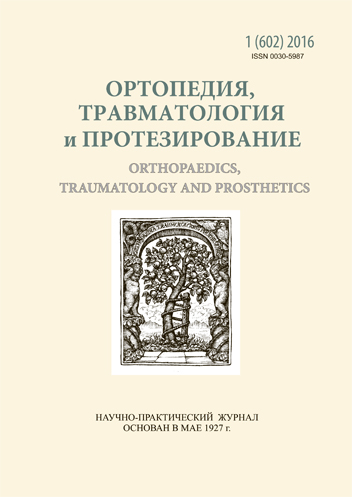The definition of indication for the surgical treatment on menisci
DOI:
https://doi.org/10.15674/0030-59872016134-40Keywords:
meniscus, arthroscopy, knee joint structure abnormality, treatment tacticsAbstract
Pathology of knee menisci (KM) leads to osteoarthritis (OA) development in 20–40% in nearest 7–10 years after primary surgical treatment. The same situation is observed after the arthroscopic interventions.
Goal of investigation: to show the most common tactical mistakes during the surgical interventions on menisci.
Methods of investigation: the results of treatments of 131 patients with meniscus pathology of different genesis from 5 to 36 years after primary surgery. The patinets were divided into 3 groups: I (85 patietns) — meniscogenic syndrom, determined by congenital predisposition, II (19 patients) — traumatic injury of meniscus; III (7 patients) — pathic pathology. OA stages were determined according to Kellgren-Lawrence classification.
Results: the most common mistakes in the meniscus surgery were determined. It was found out, that the worst results developed in the conditions of frontal deformity on knee level. The resection of meniscus under these circumstances increased OA development. The development of pain, in remote terms after operation, localized in anterior parts determined by the status of femur-patella joint. It was proved that if an angle of varus deformity on knee joint (KJ) is equal to 8°, pressure on medial meniscus is increased on 30.8 %, that provokes its disruption. Outcome: its necessary to assess KJ structure during the planning of meniscus surgery. Lateral X-ray view charcterizes the interrelationship between patella and distal femur joint surface contacting with patella, that play a large role for determing an abnormality of patella-femoral joint. MRI and CT are the modern methods of investigation, meanwhile they allow to assess meniscus damage only, but not the status of KJ in general. That is why these methods of investigation are just additional for the patients with meniscus abnormality.References
- Baburkina EP. Surgical tactics in meniscal pathology. Orthopedics, Traumatology and Prosthetics. 2002;(4):52–6.
- Baburkina EP, Snisarenko PI. Meniskogenny arthrosis. Annals of Traumatology she orthopedics. 2003;(1–2):110–2.
- Baburkina EP, Simenach BI, Pustovoyt BA. Regarding meniscal injuries in a frontal deformities at the knee. Mistakes and complications in traumatology and orthopedics. Kyiv, 2009, pp.48–52.
- Baburkina EP, Simenach BI. Theoretical and methodological background to the development of arthritic changes after artroskopichecal interventions on the knee joint: abstracts book of VIII Congress Moscow, 2009:25.
- Baburkina EP, Karpinskaya ED. On the question of pathology meniscus in usd- ditions front deformations. Orthopedics, Traumatology and protesing. 2011;4(585):34–7.
- Baburkina EP, Simenach BI, Pustovoyt BA. Errors diagnostic and treatment tactics in the pathology of menisci of the knee. Sat. scientific. works of XV Congress of Orthopedists and Traumatologists of Ukraine. Kharkiv, 2013:509–10.
- Baburkina EP. Pathology menisci of the knee joint (Genesis, medical-diagnostic tactics). Saarbrucken, Deutschland: LAP LAMBERT, 2014. 261 p.
- Makushin VD, Chegurov MYu, Biryukova MYu. Treatment effects of meniscus injuries of the knee. Traumatology and orthopedics Russia. 2006;2(40):191.
- Maslov AP. Meniscus injuries of the knee (arthroscopic diagnosis and risk factors for pathological changes): Abstract. Dis. on competition uch. PhD degree. Minsk, 1998. 20 p.
- Barks RT, Metcalf MH, Metcalf RW. Fifteen-year follow-up of arthroscopic partial meniscectomy. Arthroscopy. 1997;13:673–9.
- Sun Y, Haines N, Roberts A, Ruffolo M, Mauerhan DR, Mihalko KL, Ingram J, Cox M, Hanley ENJr. Disease-modifying effects of phosphocitrate and phosphocit-rate-β-ethyl ester on partial meniscectomy-induced osteoarthritis. BMC Musculoskelet. Disord. 2015;16(1):270. doi: 10.1186/s12891-015-0724-x.
- Kim SJ, Lee SK, Kim SH, Jeong JH, Kim HS, Lee SW, Lee JH, Jung M. Does decreased meniscal thickness affect surgical outcomes after medial meniscectomy? Am. J. Sports Med. 2015.Vol.43(4):937–44. doi: 10.1177/0363546514544677.
- Ayral X, Bonvarlet JP, Simonnet J, Auleley GR, Dougados M, Ravaud P. Influence of medial meniscectomy on tibiofemoral joint space width. Osteoarthritis Cartilage. 2003;11(4):285–9.
- Rangger C, Kathrein A, Klestil T, Glotzer W. Partial meniscectomy and osteoarthritis. Implications for treatment of athletes. Sports Med. 1997;23(1):61–8.
- Mordecai SC, Al-Hadithy N, Ware HE, Gupte CM. Treatment of meniscal tears: An evidence based approach. World J Orthop. 2014;5(3):233–41. doi: 10.5312/wjo.v5.i3.233.
Downloads
How to Cite
Issue
Section
License
Copyright (c) 2016 Elena Baburkina

This work is licensed under a Creative Commons Attribution 4.0 International License.
The authors retain the right of authorship of their manuscript and pass the journal the right of the first publication of this article, which automatically become available from the date of publication under the terms of Creative Commons Attribution License, which allows others to freely distribute the published manuscript with mandatory linking to authors of the original research and the first publication of this one in this journal.
Authors have the right to enter into a separate supplemental agreement on the additional non-exclusive distribution of manuscript in the form in which it was published by the journal (i.e. to put work in electronic storage of an institution or publish as a part of the book) while maintaining the reference to the first publication of the manuscript in this journal.
The editorial policy of the journal allows authors and encourages manuscript accommodation online (i.e. in storage of an institution or on the personal websites) as before submission of the manuscript to the editorial office, and during its editorial processing because it contributes to productive scientific discussion and positively affects the efficiency and dynamics of the published manuscript citation (see The Effect of Open Access).














